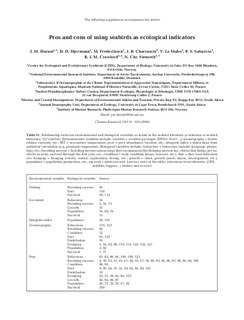Pros and cons of using seabirds as ecological indicators
Durant, Joël M.; Hjermann, Dag Ø.; Frederiksen, Morten; Charrassin, Jean-Benoit; Le Maho, Yvon; Sabarros, Philippe Sunil; Crawford, Robert J.M.; Stenseth, Nils Christian
Journal article, Peer reviewed
Permanent lenke
http://hdl.handle.net/11250/109075Utgivelsesdato
2009-07-14Metadata
Vis full innførselSamlinger
- Articles [3012]
Originalversjon
http://dx.doi.org/10.3354/cr00798Sammendrag
Climate change and overfishing are increasingly causing unanticipated changes in
marine ecosystems (e.g. shifts in species dominance). In order to understand and anticipate these
changes, there is a crucial need for indicators that summarise large quantities of information into a few
relevant and accessible signals. Seabirds have been suggested as good candidates for ecological indicators
of the marine environment; however, few studies have critically evaluated their value as such.
We review the role of seabirds as ecological indicators, and discuss their limitations and drawbacks, as
compared to other types of indicators. In addition, we highlight the statistical consequences of inverse
inference when using seabird data as indicators. We discuss the use of integrated indices and the use
of seabirds as autonomous samplers of the marine environment. Finally, we highlight the necessary
steps preceding the use of seabirds as indicators. We conclude that, in order to use seabird time series
properly, the use of recent advances both in statistics and in remote sensing is a way to move forward.
This, along with the assessment of their usefulness, should enable us to use seabird indicators appropriately
for managing urgent conservation problems.
